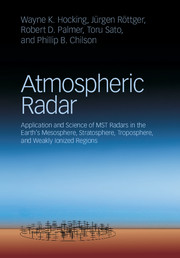 Atmospheric Radar
Atmospheric Radar Book contents
- Frontmatter
- Contents
- Preface
- Acknowledgments
- 1 An overview of the atmosphere
- 2 The history of radar in atmospheric investigations
- 3 Refractive index of the atmosphere and ionosphere
- 4 Fundamental concepts of radar remote sensing
- 5 Configuration of atmospheric radars – antennas, beam patterns, electronics, and calibration
- 6 Examples of specific atmospheric radar systems
- 7 Derivation of atmospheric parameters
- 8 Digital processing of Doppler radar signals
- 9 Multiple-receiver and multiple-frequency radar techniques
- 10 Extended and miscellaneous applications of atmospheric radars
- 11 Gravity waves and turbulence
- 12 Meteorological phenomena in the lower atmosphere
- 13 Concluding remarks
- Appendix A Turbulent spectra and structure functions
- Appendix B Gain and effective area for a circular aperture
- List of symbols used
- References
- Index
12 - Meteorological phenomena in the lower atmosphere
Published online by Cambridge University Press: 25 November 2016
- Frontmatter
- Contents
- Preface
- Acknowledgments
- 1 An overview of the atmosphere
- 2 The history of radar in atmospheric investigations
- 3 Refractive index of the atmosphere and ionosphere
- 4 Fundamental concepts of radar remote sensing
- 5 Configuration of atmospheric radars – antennas, beam patterns, electronics, and calibration
- 6 Examples of specific atmospheric radar systems
- 7 Derivation of atmospheric parameters
- 8 Digital processing of Doppler radar signals
- 9 Multiple-receiver and multiple-frequency radar techniques
- 10 Extended and miscellaneous applications of atmospheric radars
- 11 Gravity waves and turbulence
- 12 Meteorological phenomena in the lower atmosphere
- 13 Concluding remarks
- Appendix A Turbulent spectra and structure functions
- Appendix B Gain and effective area for a circular aperture
- List of symbols used
- References
- Index
Summary
Introduction
Some of the earliest applications of windprofiler radars were in regard to tropospheric and lower stratospheric studies. The radars developed at the Sunset site near Boulder, Colorado (Green et al., 1979) and in the Harz mountains in Germany (the SOUSY radar (Czechowsky et al., 1976)) were two of the earliest such instruments, and were certainly built with meteorological studies in mind. Some of these radars have already been described in Chapter 2, and the SOUSY radar was extensively discussed in Chapter 6.
The most direct meteorological studies have been in regard to wind motions, but these radars have also been usefully employed in other areas, including studies of turbulence strengths and anisotropy, tropopause height measurements, gravity wave momentum fluxes, precipitation measurements, temperature profile determinations, and various others.
It is impossible to cover all aspects of MST radar applications relating to the troposphere in just one chapter. For this reason, we will concentrate mainly on results, rather than on specific details about techniques. It will be assumed that the techniques have been sufficiently covered in earlier chapters.
The early years of tropospheric studies have been especially well covered in several excellent reviews, including those by Röttger and Larsen (1990), Gage (1990), Larsenand Röttger (1982) and Balsley and Gage (1982). Some of the early parts of this chapter will involve a recap of the main results of those publications.
Röttger and Larsen (1990) discussed the origins of VHF MST radar studies in the context of: (i) developments following the use of high-power X, S, and UHF band radars in the United States of America, as well as FMCW (frequency modulated continuous wave) techniques; coupled with (ii) the detection of tropospheric echo fading observed at Jicamarca (Peru) by Woodman and Guillen (1974); and (iii) the application of phasecoherent techniques. These events in turn led to the first dedicated VHF-ST radars being built at Sunset, near Boulder, Colorado, and in the Harz mountains of Germany (the SOUSY, sounding system radar). Phase coherent detection was especially important in the development of such systems, for without it, detection of useful tropospheric echoes with VHF systems would be nearly impossible.
- Type
- Chapter
- Information
- Atmospheric RadarApplication and Science of MST Radars in the Earth's Mesosphere, Stratosphere, Troposphere, and Weakly Ionized Regions, pp. 672 - 730Publisher: Cambridge University PressPrint publication year: 2016
